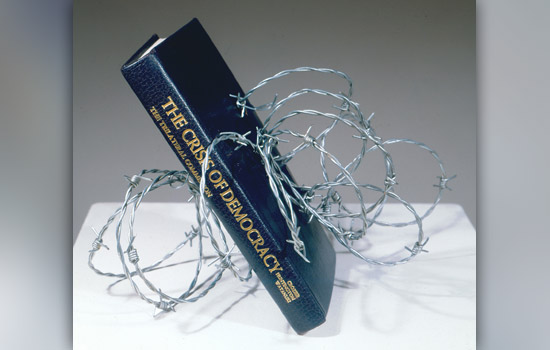Book artist to speak Thursday
The illustrated talk will focus on the relationship between image, material and metaphor
Richard Minsky uses unconventional bookbinding techniques to create art that communicates metaphors about books such as The Crisis of Democracy.
An old adage says “You can’t judge a book by its cover,” but for 50 years Richard Minsky has been using unconventional bookbinding techniques to create sculptural, often political, pieces of art. The artist will deliver an illustrated talk at RIT to demonstrate how his works of book art are designed to manipulate emotion, intellect and consciousness through sight and touch.
The talk, “Material Meets Metaphor,” will take place at 6 p.m. Thursday, April 27, at the Cary Graphic Arts Collection on the third floor of The Wallace Center. The event is free and open to the public.
“The focus is how to use everything that is known about human psychology and physiology to communicate metaphors,” explained Minsky. “In particular I discuss how to use the materials you’re working with to elicit a specific response from the viewer.”
Minsky founded the Center for Book Arts in New York City in 1974 and his work has been featured in exhibits across the country. Yale University, repository of the Richard Minsky Archive, showcased a 50-year retrospective of his work in 2010, which evolved into The Book Art of Richard Minsky, published by George Braziller the following year.
Minsky will serve as an artist-in-residence at the Cary Graphic Arts Collection from April 24-28. While staying at RIT, he will produce a variety of works on the Cary Collection’s Kelmscott/Goudy Albion iron hand press, originally owned by English designer William Morris. In 1896, Morris used the press to print the celebrated Works of Geoffrey Chaucer, which is considered to be among the most beautiful books ever produced and a major influence on the modern private press movement. “I couldn’t pass up the opportunity to create projects using such an important piece of printing history,” Minsky said.
Among the projects Minsky plans to print while on campus are pieces of book art relating to Sinclair Lewis’s 1935 political novel It Can’t Happen Here. The novel depicts the rise of fictional politician “Buzz” Windrip, who defeats Franklin Delano Roosevelt to be elected president of the United States and imposes totalitarian rule. In the novel, a resistance movement forms and spreads their ideas by printing anti-Windrip pamphlets and covertly placing them inside books and magazines. “I will be creating a physical pamphlet to insert in a copy of the first edition using methods similar to those described in the book,” Minsky said.














